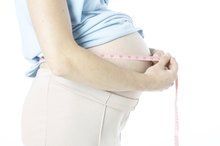Abdominal Pain With Spotting
Anytime you experience abdominal pain with vaginal spotting, there is a good chance the cause is related to your reproductive system. Vaginal spotting most often comes from the uterus, although bleeding from the cervix or vagina could also cause spotting. Many conditions -- some serious, some not -- can cause abdominal pain and spotting. Call your doctor if you have concerns about these symptoms.
If you are experiencing serious medical symptoms, seek emergency treatment immediately.
Menstrual Cycle Causes
Some women experience abdominal pain, typically on one side, at the time of ovulation. This type of pain, called mittelschmerz, is sometimes accompanied by light spotting and is not dangerous. Mittelschmerz normally lasts just a day or two. You might also have cramping or abdominal pain accompanied by spotting for a day or two before your period starts.
- Some women experience abdominal pain, typically on one side, at the time of ovulation.
- This type of pain, called mittelschmerz, is sometimes accompanied by light spotting and is not dangerous.
Ovarian Cysts
Does Pineapple Juice Help the Lining of the Uterus?
Learn More
Some women develop cysts within the ovary. While many ovarian cysts cause no symptoms, larger cysts may cause abdominal pain along with spotting. Rupture of an ovarian cyst can also cause pain, spotting and bleeding in the abdomen. In rare cases, a large cyst can cause twisting of the ovary, cutting off its blood supply and causing severe pain. Call your doctor if you experience severe pain and spotting.
- Some women develop cysts within the ovary.
- While many ovarian cysts cause no symptoms, larger cysts may cause abdominal pain along with spotting.
Endometriosis and Fibroids
Endometriosis is a chronic condition in which uterine tissue grows outside the uterus. Abdominal pain accompanied by spotting or heavy bleeding can occur. Endometriosis may interfere with getting pregnant and cause scar tissue formation within the pelvis. Uterine fibroids -- noncancerous growths of the uterus -- can also cause spotting and abdominal pain.
- Endometriosis is a chronic condition in which uterine tissue grows outside the uterus.
- Endometriosis may interfere with getting pregnant and cause scar tissue formation within the pelvis.
Pregnancy-Related Causes
Brown Spotting After Menopause
Learn More
Some of the most potentially serious causes of abdominal pain and spotting occur during early pregnancy. A threatened miscarriage can cause these symptoms. An ectopic pregnancy -- which develops outside the uterus, usually in the fallopian tube -- is another possible cause. Ectopic pregnancy can lead to rupture of the fallopian tube, causing severe and potentially fatal blood loss. According to the December 2012 text "Ectopic Pregnancy and Miscarriage," 64 percent of women with an ectopic pregnancy experience vaginal bleeding and 93 percent have abdominal or pelvic pain 4. A less serious cause of early pregnancy bleeding occurs when the embryo first begins to burrow into the uterine lining, sometimes causing spotting and cramping around the time of an expected period. Call your doctor immediately if you may be pregnant and experience abdominal pain and spotting that lasts more than a day.
- Some of the most potentially serious causes of abdominal pain and spotting occur during early pregnancy.
- According to the December 2012 text "Ectopic Pregnancy and Miscarriage," 64 percent of women with an ectopic pregnancy experience vaginal bleeding and 93 percent have abdominal or pelvic pain 4.
Postmenopausal Causes
Any vaginal bleeding after menopause merits immediate medical attention. The most serious cause of vaginal bleeding at this time is uterine cancer. Approximately 90 percent of women with uterine cancer -- also called endometrial cancer -- have abnormal vaginal bleeding or discharge, according to a November 2009 "American Family Physician" article 10. Uterine cancer can, but does not always, cause abdominal pain. Postmenopausal women sometimes experience pelvic pain or pain during intercourse, which may be followed by light spotting. This spotting is typically due to slight trauma to the vaginal lining, which becomes thin after menopause.
Reviewed by: Tina M. St. John, M.D.
- Any vaginal bleeding after menopause merits immediate medical attention.
- This spotting is typically due to slight trauma to the vaginal lining, which becomes thin after menopause.
Related Articles
References
- The American College of Obstetricians and Gynecologists Practice Bulletin: Management of Endometriosis
- American Family Physician: Office Management of Early Pregnancy Loss
- Ectopic Pregnancy and Miscarriage: Diagnosis and Initial Management in Early Pregnancy of Ectopic Pregnancy and Miscarriage; National Collaborating Centre for Women's and Children's Health (UK)
- Human Reproduction: Vaginal Bleeding in Very Early Pregnancy
- Manuel of Obstetrics, 8th Edition; Arthur T. Evans, M.D., and Emily DeFranco, D.O.
- Nursing: Interpreting Signs and Symptoms; Lippincott Williams and Wilkins
- Clinical Sonography: A Practical Guide, 4th Edition; Roger C. Sanders and Tom C. Winter, M.D.
- Rosen and Barkin’s 5-Minute Emergency Medicine Consult, 4th Edition; Jeffrey J. Schaider, M.D., et al.
- International Journal of Gynecological and Obstetrical Research: Pain -- An Atypical Presentation of Endometrial Cancer: Case Report and Literature Review
- American Family Physician: Endometrial Cancer
- Intrauterine devices: an effective alternative to oral hormonal contraception. Prescrire Int. 2009;18(101):125-30.
- Intrauterine devices: an effective alternative to oral hormonal contraception. Prescrire Int. 2009;18(101):125-30.
- Hosseini R, Asgari Z, Moini A. Unexpected outcome after expectant management of ectopic pregnancy in two persons. Iran J Reprod Med. 2013;11(12):1027-30.
- Intrauterine devices: an effective alternative to oral hormonal contraception. Prescrire Int. 2009;18(101):125-30.
- Bautista CT, Wurapa E, Sateren WB, Morris S, Hollingsworth B, Sanchez JL. Bacterial vaginosis: a synthesis of the literature on etiology, prevalence, risk factors, and relationship with chlamydia and gonorrhea infections. Mil Med Res. 2016;3:4. doi:10.1186/s40779-016-0074-5
- Khan AT, Shehmar M, Gupta JK. Uterine fibroids: current perspectives. Int J Womens Health. 2014;6:95-114. doi: 10.2147/IJWH.S51083
- Domingues AP, Lopes H, Dias I, De oliveira CF. Endometrial polyps in postmenopausal women. Acta Obstet Gynecol Scand. 2009;88(5):618-20. doi:10.1080/00016340902818188
- Mayo Clinic. Vaginal Bleeding.
- MedlinePlus. Vaginal Bleeding Between Periods.
Writer Bio
A registered nurse with more than 25 years of experience in oncology, labor/delivery, neonatal intensive care, infertility and ophthalmology, Sharon Perkins has also coauthored and edited numerous health books for the Wiley "Dummies" series. Perkins also has extensive experience working in home health with medically fragile pediatric patients.








